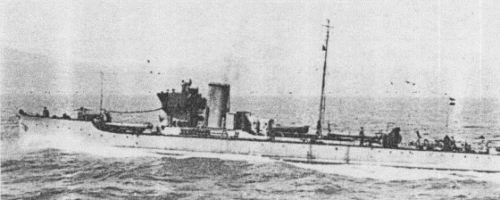
NAVYPEDIA
 Support the project with paypal
Support the project with paypal
Photo

81T 1917 Many thanks to Wolfgang Stöhr for additional information on this page.
Ships
| Name | No | Yard No | Builder | Laid down | Launched | Comp | Fate |
|---|---|---|---|---|---|---|---|
| 74T | 466 | STT, San Marco | 4/1913 | 28.8.1913 | 6/1914 | to Romania 1920 (Viforul) | |
| 75T | 467 | STT, San Marco | 5/1913 | 20.11.1913 | 7/1914 | to Romania 1920 (Vartejul) | |
| 76T | 468 | STT, San Marco | 6/1913 | 15.12.1913 | 7/1914 | to Yugoslavia 1920 (T1) | |
| 77T | 469 | STT, San Marco | 8/1913 | 30.1.1914 | 8/1914 | to Yugoslavia 1920 (T2) | |
| 78T | 470 | STT, San Marco | 10/1913 | 4.3.1914 | 8/1914 | to Yugoslavia 1920 (T3) | |
| 79T | 471 | STT, San Marco | 12/1913 | 30.4.1914 | 9/1914 | to Yugoslavia 1920 (T4) | |
| 80T | 472 | STT, San Marco | 12/1913 | 3.8.1914 | 11/1914 | to Romania 1920 (Vijelia) | |
| 81T | 473 | STT, San Marco | 2/1914 | 6.8.1914 | 12/1914 | to Romania 1920 (Sborul) |
Technical data
| Displacement normal, t | 262 |
|---|---|
| Displacement full, t | 320 |
| Length, m | 58.2 wl 57.3 pp |
| Breadth, m | 5.70 |
| Draught, m | 1.50 |
| No of shafts | 2 |
| Machinery | 2 Parsons steam turbines, 2 Yarrow boilers |
| Power, h. p. | 5000 |
| Max speed, kts | 28 |
| Fuel, t | coal 18 + oil 24 |
| Endurance, nm(kts) | 980(16) |
| Armament | 2 x 1 - 66/27 G. L/30 K.09, 2 x 2 - 450 TT, 10 - 12 mines |
| Complement | 39 |
Standard scale images

78T 1918
Graphics
Project history
In 1910 the Naval Technical Committee ordered the development of a 275t coastal torpedo-boat, capable of sustaining 30kts for 10 hours (this being the duration of a passage from Cattaro to the Otranto Straits, time to gain contact and attack before morning, and return at full speed - four years before the war such torpedo-boat attacks on enemy forces blockading the Otranto Straits were clearly predicted). Turbines, diesel and turbo-electric propulsion were discussed, but the decision was quickly made: diesels in the necessary dimensions were not available; and turbo-electric propulsion would not be advisable without the practical experience gained by running a test vessel. Of the two yards competing, STT won the contract for eight boats. Although their particulars were very nearly those requested by the Navy for the coastal torpedo-boat, they were classified as sea-going boats. Being the first Austrian turbine-powered small units, it is not surprising that the first boats experienced constant troubles with their machinery. Initially they were to be armed with 3-66mm/30 guns and 3 TT (1 x 2, 1 x 1) but for reasons of standardization they received the same armament as the following Danubius-built class.
Modernizations
1914, all: + 1 x 1 - 8.80
1917, all: - 1 x 1 - 66/27; + 1 x 1 - 75/27 G. L/30 K.16 BAG
Naval service
All boats saw active service on convoy, submarine hunting, escort and minesweeping duties, and all survived the war. Tb74, 75, 80 and 81 were allocated to Rumania in 1920, the first three being stricken in 1927, but Sborul was in service until 1958. Tb 76-79 were allocated to Yugoslavia: T4 was lost after stranding in 1932; T2 was stricken in 1939; T1 and T2 were incorporated into the Italian Navy in April 1941, under their old designations. After the collapse of Mussolini's empire, the former T1 was returned to the navy of the independent Croatian state on 7 December 1943 renamed Golesnica and served with the later Yugoslavian Navy until 1959. The former T2 also became part of the navy of independent Croatia in 1943, but served as the German TA48 with an exclusively Croatian crew; she sank after suffering bomb hits on 20 February 1945 at Trieste.
Many thanks to Wolfgang Stöhr for additional information on this page.
 HOME
HOME FIGHTING SHIPS OF THE WORLD
FIGHTING SHIPS OF THE WORLD AUSTRIA-HUNGARY
AUSTRIA-HUNGARY TORPEDO SHIPS
TORPEDO SHIPS TB 74T torpedo boats (1914)
TB 74T torpedo boats (1914)
